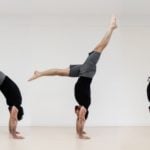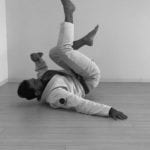Maybe you’re recovering from a sprain or a strain. Or you have to stop and shake your wrists out whenever you do push-ups. Or your wrists are just screaming from the hours you spend at your computer.
Whatever the cause, these wrist exercises can help.
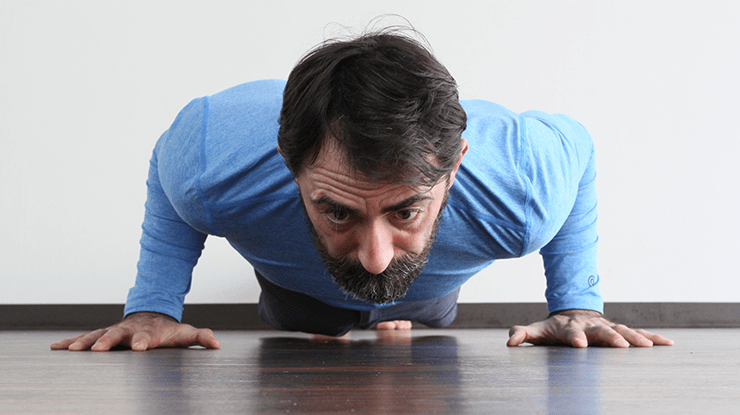
First of all, because you need your wrists for many normal, necessary daily activities. And second, it’s hard to keep your upper body strong without pushing movements that load your arms and shoulders through your wrists—the very movements that can be excruciating with wrist pain!
Many people with wrist trouble think they only have two options: wait it out or see a professional (and you should see a professional if your problem doesn’t improve).
In this article, I’ll show you a third option: how to actively fix your wrists using a series of wrist exercises that only take a few minutes every day.
I’ve successfully used these exercises with my physical therapy patients for years, and recently one client of ours, a sports orthopedic surgeon, let us know that he’s been using them with his patients, too:
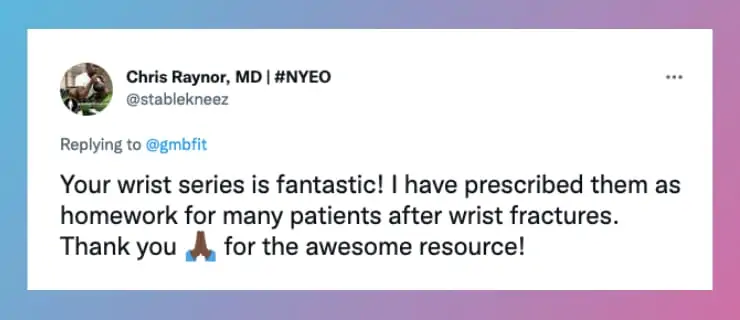
First, we’ll go over 5 wrist stretches that will ease pain and give you better range of motion. Then we’ll go over 4 wrist strengthening exercises that protect your wrists over the long term.
But first let’s take a quick look at what’s happening inside your wrist and why these exercises are important…
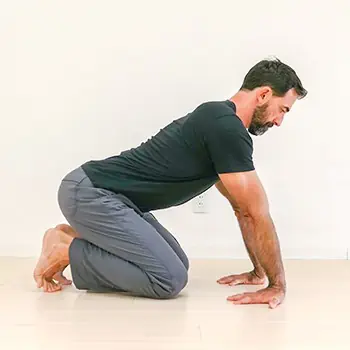
Download the Full Routine
Get the proven 8-stretch sequence that’s helped thousands of people build healthy wrists, yours free.
A Very Brief Overview of How the Wrist Works
 Here’s a little refresher on wrist anatomy to help you understand what’s going wrong and how to fix it.
Here’s a little refresher on wrist anatomy to help you understand what’s going wrong and how to fix it.
There are ten bones connected to the wrist joint. You’ve got the two coming in from your forearm (the radius on the thumb side and the ulna on the pinky side), and then eight coming in from the hand, which are called carpals.
The bones and ligaments are supportive structures of course. But just as in anything, if they are not acclimated to the forces of vigorous, repetitive training, they will lack the resilience to withstand injury. As such, ligament sprain and bone stress fractures are common problems.
Improving the capacity of our wrist bones and ligaments takes consistent, progressive, and patient work. And if you want to reduce your risk of injuries, the patience part is key.
The muscles of our forearms and wrists create the movements of flexion, extension, and radial/ulnar deviation. Hand rotations (supination and pronation) actually come from the elbow joints. So wrist “circle” exercises are a combination of elbow and wrist movements.
Our forearm and hand muscles actually have a great potential for strength improvement, as again most of us tend not to use them to their full capability.
Steady incremental strength and mobility training for the wrists can lead to significant results. That’s what these routines will help you do.
5 Wrist Stretches For More Range Of Motion
If your wrists are giving you trouble, lots of trainers and fitness gurus will throw a bunch of random stretches at you or just tell you to “stretch more” if it’s not getting better.
But that’s the difference with this routine: it’s not random.
I’ve been working with patients as a physical therapist since 1998 and have also gotten to help thousands of clients through GMB. This sequence is based on many years of experience of what actually helps your wrists feel and work better.
🎁 Build strong, healthy wrists with this proven routine that’s helped thousands of people move better with less pain. Yours free. Just tell us where to send it.
You’ll notice a lot of the movements have two parts: first pulsing in and out of the stretched position, then holding the stretch. This mix of static of and dynamic stretching has been shown to help your body feel comfortable allowing more range of motion.
Instead of pushing into discomfort, relax into the holds. It helps train your nervous system that this is a safe position for you.
Now let’s look at each exercise in detail…
1. Wrist Circles To Increase Range Of Motion
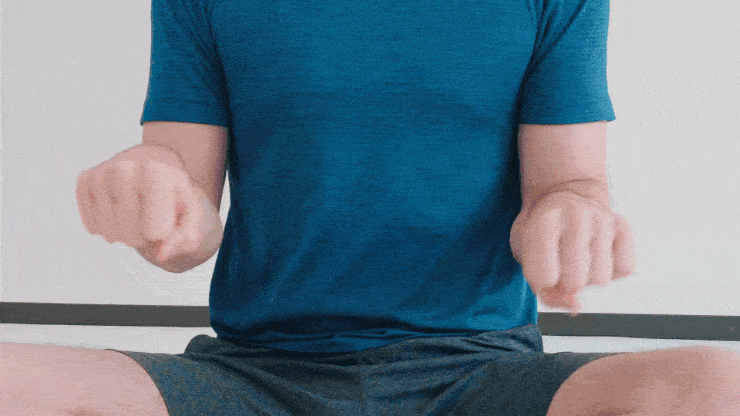
- Bring your hands up with your elbows close to your body, making fists.
- Rotate your wrists in a circular motion.
- Try to keep your palms facing downward to maximize range of motion.
- Do 15-20 circles in each direction.
2. Backward Facing Wrist Stretch
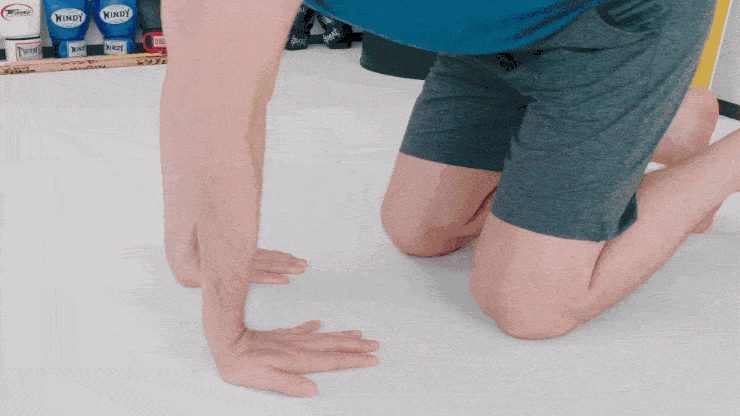
- Place your hands out in front of you, rotating your wrists around so that your fingers are facing your knees.
- Start with your fingers closer to your knees (this is easier than further away).
- Keeping your palms flat on the ground, shift your body back toward your heels, then forward toward your hands.
- Do 5 repetitions and hold for 5-10 seconds on the 5th rep, and repeat again for one more round..
3. Forward Facing Wrist Stretch
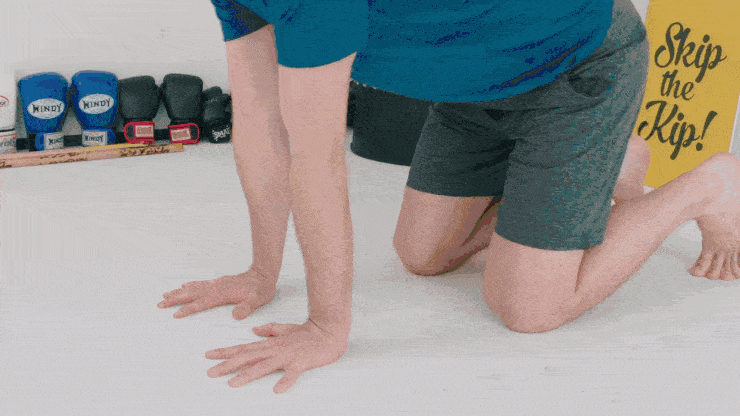
- Start with your hands flat on the floor in front of you with fingers facing forward.
- Make sure your elbow pits are facing forward and pulse forward for 5 reps, holding for 5-10 seconds on the 5th rep.
- Do one more round of pulses with a hold at the end.
4. Palm Heel Up Side-To-Side Stretch
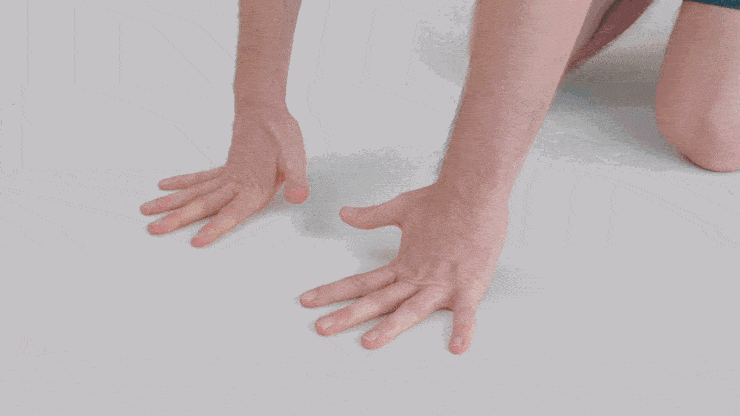
- Make sure your hands are flat on the ground with fingers spread out.
- Lift the heel of your hands up off the ground. Then push your hands into the ground while focusing on the knuckles, and go side to side.
- If this position is tough, bring your hands closer to your body.
- Do this for about 15 seconds going side to side.
5. Wrists Shakes
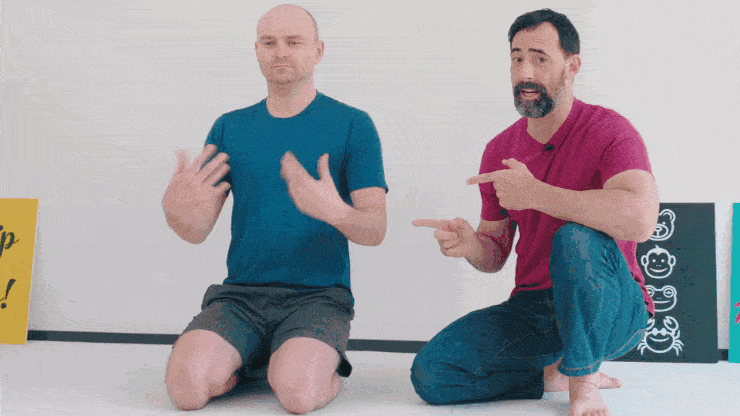
- Simply shake your wrists out for 10-15 seconds (just like Andre 3000 so eloquently said in Hey Ya).
Practicing these exercises will help you improve your range of motion in your wrists, which can help you access more movements with less restriction and pain. Which makes them a great starting place for improving your wrist health.
But for your wrists to function at their best they also need to be strong. So this next sequence focuses on wrist strength.
4 Wrist Exercises For More Strength
Strong wrists are more resilient when something unexpected happens.
The exercises in this routine will help you build the kind of wrist strength that will help keep your wrists healthy and injury free, even when
🎁 Build strong, healthy wrists with this proven routine that’s helped thousands of people move better with less pain. Yours free. Just tell us where to send it.
Again, don’t push into any painful positions. If something hurts back off and try and easier version of it.
Building strong wrists is a process. But if you practice these moves regularly at your own level you’ll be well on your way to healthy, resilient wrists.
Here are the 4 exercises broken down:
1. Palm Pulses
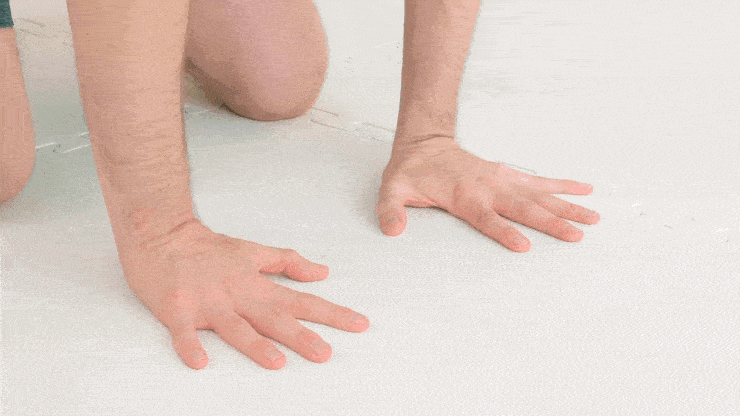
- Put your hands flat on the ground, splaying your fingers as wide as you can.
- Pull your palms off the ground, keeping the top part of your hand and your fingers pressed into the ground.
- Pulse in and out of this position 10-30 times.
2. Back of the Hand Wrist Extension
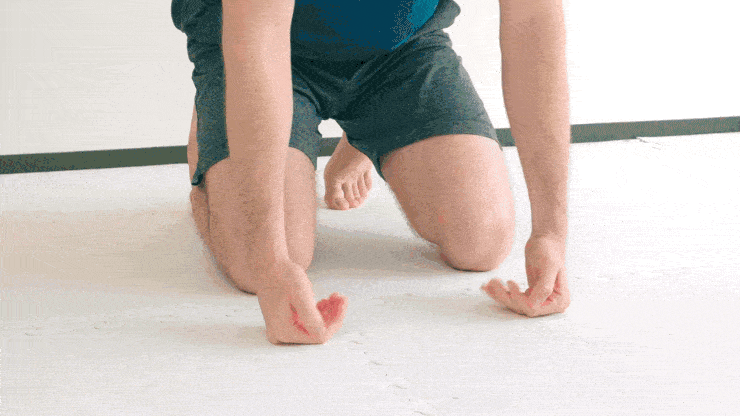
- Start with your knuckles on the floor with your arms straight.
- Adjust your weight by sitting back or leaning forward.
- Open your palms, and roll the back of your hands to be flat on the ground.
- Do 2 sets of 8-10 reps.
3. Seal Walk
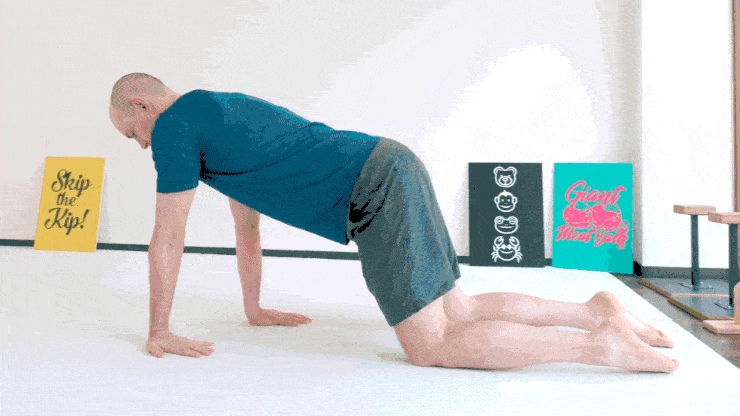
- Start with your palms on the ground, with fingers facing your knees.
- Shoulders over your hands.
- Walk forward, crawling on your hands and knees, trying to keep your chest up.
- Do 2 sets of 10-12 reps per hand.
4. Rear Facing Wrist Holds
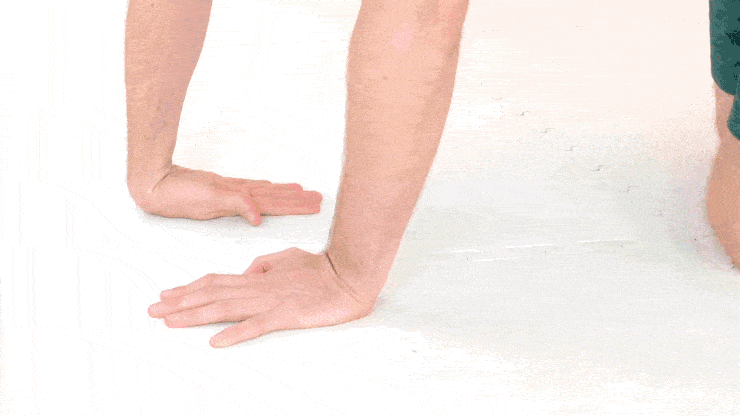
- Start with the back of your hands on the floor, fingers pointing toward your knees.
- Hold the position for 3-10 seconds and aim to work toward a full 30 second hold.
When stiff, sore wrists are holding you back the most important thing to do is to address that problem! That’s what these exercises will help with.
But you might also wonder what’s going on with your wrists in the first place. So let’s take a look at that…

Download the Full Routine
Get the proven 8-stretch sequence that’s helped thousands of people build healthy wrists, yours free.
How Your Stiff, Weak Wrists are Holding You Back
There are quite a few wrist conditions (strains, sprains, tendonitis, bursitis, TFCC tears, stress fractures) that can be improved with proper wrist conditioning.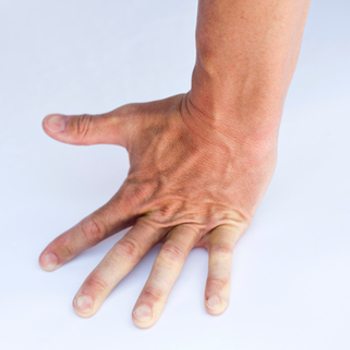
The beginning of wrist conditioning work is ensuring you have the adequate wrist flexibility to perform your training safely. You want to be able to flex and extend your wrists to at least 90 degree angles without a lot of force for most training that loads your wrists.
If your wrists can’t flex and extend properly, loading them with your bodyweight (or more) through training is like finding a stuck hinge and, instead of loosening it properly, just pushing harder and harder until something gives.
There is also quite a bit of wrist strength-endurance needed to perform bodyweight exercise, especially in exercises involving some level of hand balancing. While the common recommendation for building wrist conditioning is to spend as much time on your hands as possible, you have to work up to it, especially if your wrists already hurt.
“What if these exercises are too uncomfortable for me?”
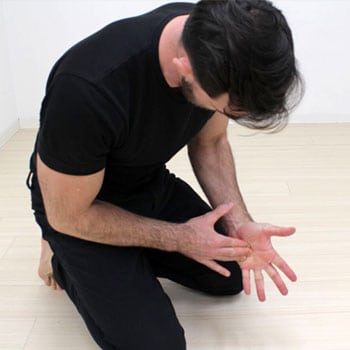 If your wrists are so restricted that you can’t perform the exercises as shown in the videos, don’t worry about it. You just have to adjust to your own level.
If your wrists are so restricted that you can’t perform the exercises as shown in the videos, don’t worry about it. You just have to adjust to your own level.
A good option is to do the exercises on a table or other elevated surface to take some of the pressure off.
And if even that is too uncomfortable, feel free to do them on a wall.
The important thing is to move within the range you can, and not to move into pain. Stop just short of where you feel pain and spend time working on the range you’ve got.
Over time, that range will increase and you’ll be doing more and feeling better.
You can also make your wrists robust using animal movements.
Once you have the strength a mobility in your wrists to support your body weight, we recommend getting familiar with animal movements, specifically the Bear, Monkey, and Frogger.
Get Past Restrictions and Get Back to Doing the Things You Love
Feeling restricted from activities you want to do is a terrible feeling. You want to feel in control of your body, and to be confident that it can handle whatever you need it to do for you.
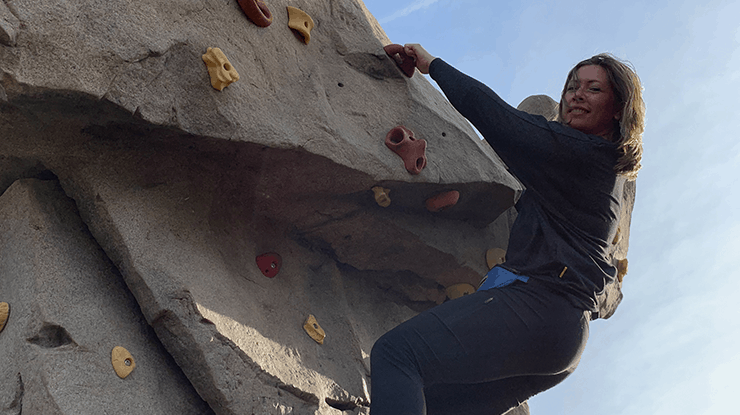
When your body is unencumbered by restrictions, you can feel truly free to pursue any activities you want.
Maybe you’ve wanted to take up climbing, or you’ve been hesitant to try something like grappling because you know it will put strain on your wrists. Once you free up that restriction with diligent practice, you’ll be free to take up any sport or activity. And that freedom is a beautiful thing.
Would the rest of your body benefit from improved flexibility and strength? Elements can help you get strong and mobile from head to toe.
Get Strong Wrists and Move Better Than Ever
Wrist health is one key component of all-around physical autonomy. Our Elements program walks you through a process of building strength, mobility, and control throughout your body.

Due to shoulder and wrist injuries from a car accident in 1997 (yes a long time ago), and gaining weight since then, I have had either too much pain, or not enough strength in my shoulders and wrists to sustain my body weight in exercises as fundamental as push-ups and planks. The lack of being physical has also gone hand-in-hand with a poor diet. Using Elements over the last several months, which has motivated me to have a more careful diet, I am close to having lost 40 pounds, reaching my doctor’s recommended weight.
Last week, for the first time in my life, I was able to hold myself in this yoga pose - achieving the strength, balance, and confidence I have really wanted for a long time and failed to achieve. I value and have used other trainings (e.g. P90X, parkour) but with GMB Elements I have been able to re-train my mind and body to work thoughtfully and consistently at getting closer to my ideal weight, strength, and flexibility.
The program reminds me so much of physical therapy from my previous accident, which involves gradual physical and psychological changes that have helped me build strength and flexibility from deep inside—making it sustainable. Sustainability has come from learning a whole set of skills I can use to maintain my growth. I have been working longer than 7 weeks with Elements, but have felt OK with that due to the supportive manner of presentation, and not having to guess what to do to improve. What is important is that right in the middle of my busiest time in grad school I have been able to incorporate GMB into my daily life.




